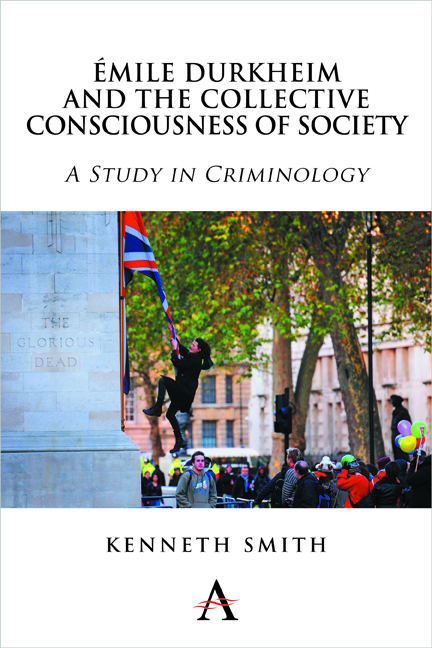Book contents
- Frontmatter
- Dedication
- Contents
- Epigraph
- Preface
- Introduction
- Part I The Concept of the Collective Consciousness of Society
- Part II The Form of the Collective Consciousness
- Preface to Part II
- Introduction to Part II: The Conditions of the Collective Consciousness of Society
- 4 The Form that the Collective Consciousness(es) of Society Takes in a Late-Industrial Society: I. Macro-sociological or ‘General’ Characteristics
- 5 The State as the ‘Organ’ of the Common Consciousness
- 6 ‘The Rule-of-Law’: A Case Study
- 7 The Form that the Collective Consciousness Takes in Early Twenty-First Century Britain: II. Micro-sociological, Individual or Small-Scale Factors
- Conclusion to Part II
- Part III Durkheim on Crime and Punishment
- Part IV Social Fact or Social Phenomenon? Durkheim's Concept of the Collective Consciousness as a ‘Social Fact’
- Part V Some Problems with Durkheim's Concept of the Common and Collective Consciousness
- Conclusion
- Appendix: On Paying a Debt to Society
- Notes
- References
- Index
Conclusion to Part II
from Part II - The Form of the Collective Consciousness
Published online by Cambridge University Press: 05 October 2014
- Frontmatter
- Dedication
- Contents
- Epigraph
- Preface
- Introduction
- Part I The Concept of the Collective Consciousness of Society
- Part II The Form of the Collective Consciousness
- Preface to Part II
- Introduction to Part II: The Conditions of the Collective Consciousness of Society
- 4 The Form that the Collective Consciousness(es) of Society Takes in a Late-Industrial Society: I. Macro-sociological or ‘General’ Characteristics
- 5 The State as the ‘Organ’ of the Common Consciousness
- 6 ‘The Rule-of-Law’: A Case Study
- 7 The Form that the Collective Consciousness Takes in Early Twenty-First Century Britain: II. Micro-sociological, Individual or Small-Scale Factors
- Conclusion to Part II
- Part III Durkheim on Crime and Punishment
- Part IV Social Fact or Social Phenomenon? Durkheim's Concept of the Collective Consciousness as a ‘Social Fact’
- Part V Some Problems with Durkheim's Concept of the Common and Collective Consciousness
- Conclusion
- Appendix: On Paying a Debt to Society
- Notes
- References
- Index
Summary
In Part II of this book I have taken seriously Durkheim's list of ‘rules forbidding acts contrary to the sentiments of the collectivity’ in table v.1 of The Division of Labour and I have argued that these rules give us a good idea of Durkheim's view of the content of the common or collective consciousness of society itself. I have then tried to complete the project, outlined by him in some detail in Moral Education but rejected by him in The Division of Labour, of mapping onto his highly theoretical and really very abstract discussion of the common and collective consciousness in The Division of Labour a detailed empirical description of some of the major characteristics of the collective consciousness of Britain at the beginning of the twenty-first century. I have argued that these things need to satisfy both of the two major conditions of the collective consciousness of society; namely, beliefs and practices which firstly assume an almost quasi-religious character for some people, and which therefore, secondly, provoke the feeling of outrage amongst those people who are closely incorporated into this view when these things are violated. Either one of these characteristics taken by itself will not be enough to identify something as a condition of a collective consciousness of society as such – so that we might well be outraged by some things (the high price of petrol in Britain perhaps) and there might well be other feelings of a quasi-religious nature (e.g., supporting a particular football team) which do not by themselves form any part of a collective consciousness of society.
- Type
- Chapter
- Information
- Publisher: Anthem PressPrint publication year: 2014



